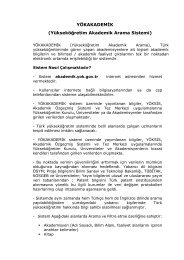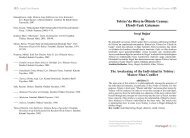0002823
0002823
0002823
Create successful ePaper yourself
Turn your PDF publications into a flip-book with our unique Google optimized e-Paper software.
ABSTRACT<br />
THE GENERIC DEVELOPMENT OF THE TIFLÎ STORIES<br />
The Tıflî stories are a group of works consisting of prose stories mostly printed in<br />
nineteenth-century Istanbul. The main contention of this study, entitled “The Generic<br />
Development of the Tıflî Stories”, is that the Tıflî stories, examined in light of the<br />
historical process of their origin, development, and decline, present a full-fledged<br />
literary genre. The Tıflî stories, whose known corpus consists of the works “Bursalı’nın<br />
Kahvehanesi” (The Coffee Shop of the One from Bursa), Hançerli Hikâye-i Garîbesi<br />
(The Strange Story of the One with the Dagger), Hikâye-i Cevrî Çelebi (The Story of<br />
Cevrî Çelebi), Hikâye-i Tayyârzâde (The Story of Tayyârzâde), “Hikâyet” (“Story”, also<br />
known as Sansar Mustafa hikâyesi, “the story of Mustafa, the Weasel”), İki Birâderler<br />
Hikâyesi (The Story of the Two Brothers), Letâ’ifnâme (Collection of Amusing Stories),<br />
Meşhûr Tıflî Efendi ile Kanlı Bektâş’ın Hikâyesi (The Famous Story of Tıflî Efendi and<br />
Bloody Bektâş), and “Tıflî Efendi Hikâyesi” (The Story of Tıflî Efendi), as well as<br />
various versions of these works, have undergone numerous changes in the course of<br />
time. These changes are examined here under various headings, using a comparative<br />
approach also drawing on various outside sources on Ottoman history and literary<br />
theory. First, the study focuses on the works’ external and linguistic properties. Under<br />
the heading of external properties, variables such as print technology, page length and<br />
page dimensions are examined, while under the heading of linguistic properties, the<br />
ways in which these relate to social strata and the development from an oral to a written<br />
language are examined. After this, the study turns to various dimensions of the<br />
worldview presented by the stories. Here, issues such as social stata, forms of<br />
entertainment, gender relations, and concepts of virtue are dealt with. Lastly, the study<br />
examines the stories according to criteria of literary, or formal, realism, correspondence<br />
to historical reality, and social relevance. The developments that the Tıflî stories exhibit<br />
in all the examined areas enable us to divide them up into three main stages of<br />
development. In the conclusion of this study, these stages are related to the theory of<br />
literary genres and contextualized as representing the main stages in a process of generic<br />
development. The study concludes that the Tıflî stories, while influenced by various<br />
literary traditions, constitute a separate literary genre of their own.<br />
keywords: realism, Ottoman literature, novel, genre<br />
iv





